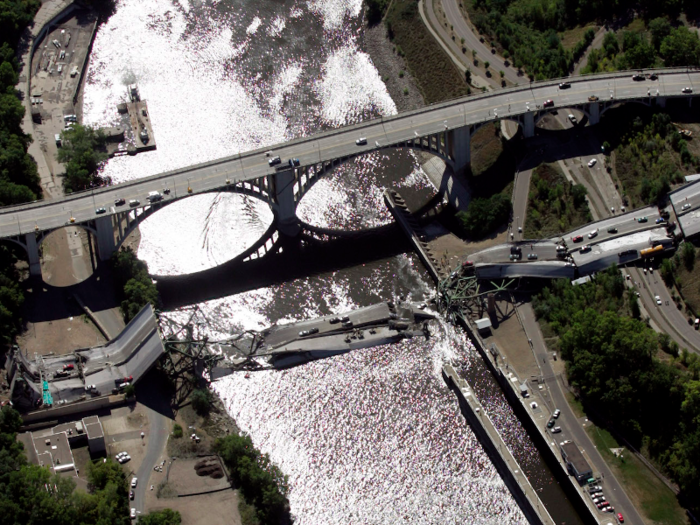
Out of 138 economies worldwide, the US ranks 11th when it comes to infrastructure competitiveness, according to the World Economic Forum’s Global Competitiveness Index.

There are about 4.2 million miles of public roadway in the US, according to the Federal Highway Administration. And in 2016 alone, there were 3.2 trillion miles driven on these roadways. All of this traffic is wearing on our roads.
In fact, 32% or one-third of major urban roads in the US are in poor condition and in need of improvement, according to a November report by Trip, a national transportation research group.

A structurally deficient bridge means that the bridge has at least one structural issue that needs to be addressed. According to the latest data from the Federal Highway Administration, about 1,900 of those 56,000 deficient bridges are on the Interstate Highway system.
Part of the problem stems simply from the fact that these structures are just old.
In fact, about 41% os US bridges are more than 40 years old and have not had significant construction work for improvement, according to a February report by The American Road & Transportation Builders Association (ARTBA).

About 25% of the bridges in Rhode Island are deficient. Nevada is the state with the lowest percentage of deficient bridges.

Driving on damaged roads can wear on cars, causing consumers to have to spend more on repairs and speed up the rate at which their car depreciates.
In fact, on average, motorists lose $523 annually because of the costs associated with driving on roads that need repairs, according to the Trip report.

The volume and cost associated with road congestion has steadily been rising since 2000, according to the DOT's 2016 Transportation Statistics Annual Report.
More time in traffic means commuters are losing not only time, but money.
In 2014, Americans spent a total of 6.9 billion hours stuck in traffic and an extra $3.1 billion on gas. In total, urban highway congestion cost the US economy $160 billion, according to the Texas A&M Transportation Institute's 2015 Urban Mobility Scorecard.

About $542.6 billion of the total backlog is needed to make repairs and about $167 billion is needed for expansion.
Enhancement costs account for 15.1 percent of the total, or $126.4 billion, according to the 2015 Status of the Nation's Highways, Bridges, and Transit: Conditions & Performance report, which was published in January.


By 2020, 70% of the US’ 87,000 dams will be over 50 years old, according to The American Society of Civil Engineers (ASCE). The organization has given our dams a D grade and estimated about 14,000 are high-hazard dams.

Federal agencies don’t control most of the country’s dams.
In fact, only 14% of dams in the USA are owned or regulated by government agencies, according to the Association of State Dam Safety Officials. So they can’t force dam owners to update the structures.

According to the ASCE, there are some 100,000 miles of levees in all 50 states and the District of Columbia. These structures help protect communities from flooding, but many are in desperate need of repair.
In fact, levees are in need of about $100 billion in repairs, according to the ASCE.

President Donald Trump has said he wants to spend $1 trillion to repair America's infrastructure. However, details about his plan remain murky at best and according to the ASCE about three times that amount is needed.
 27 emails, 10 banks accounts: Mystery of missing Taarak Mehta actor Sodhi deepens
27 emails, 10 banks accounts: Mystery of missing Taarak Mehta actor Sodhi deepens
 Sensex, Nifty rebound as Reliance, ITC gain
Sensex, Nifty rebound as Reliance, ITC gain
 IPL Decoded: Highest individual scores in IPL 2024 so far, from Stoinis to Kohli
IPL Decoded: Highest individual scores in IPL 2024 so far, from Stoinis to Kohli

Copyright © 2024. Times Internet Limited. All rights reserved.For reprint rights. Times Syndication Service.